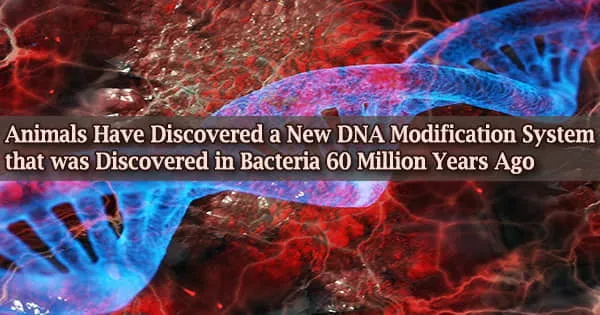Your DNA contains the blueprint for your body’s construction, but it’s a living document: Epigenetic markings can be used to make changes to the design. Epigenetic markings are changes to DNA bases that don’t modify the core genetic code, but instead “write” extra information on top of it that can be passed down down the generations.
Gene expression is normally regulated by epigenetic markers, which turn genes on or off, especially during early development or when your body is stressed. They can also stop “jumping genes,” or transposable elements that endanger your genome’s integrity.
Two major epigenetic marks have been identified in humans and other eukaryotes. In bdelloid rotifers, small freshwater invertebrates, a team from the Marine Biological Laboratory (MBL) identified a third, unique epigenetic mark previously only recognized in bacteria. This groundbreaking and unexpected discovery was published in Nature Communications this week.
“We discovered back in 2008 that bdelloid rotifers are very good at capturing foreign genes,” said senior author Irina Arkhipova, senior scientist in the MBL’s Josephine Bay Paul Center. “What we’ve found here is that rotifers, about 60 million years ago, accidentally captured a bacterial gene that allowed them to introduce a new epigenetic mark that was not there before.”
It’s the first time a horizontally transferred gene has been demonstrated to modify a eukaryote’s gene regulation system.
“This is very unusual and has not been previously reported,” Arkhipova said. “Horizontally transferred genes are thought to preferentially be operational genes, not regulatory genes. It is hard to imagine how a single, horizontally transferred gene would form a new regulatory system because the existing regulatory systems are already very complicated.”
Ballad rotifers, especially, have to keep their transposons in check because they primarily reproduce asexually. Asexual lineages have fewer means for suppressing proliferation of deleterious transposons, so adding an extra layer of protection could prevent a mutational meltdown. Indeed, transposon content is much lower in bdelloids than it is in sexual eukaryotes that don’t have this extra epigenetic layer in their genome defense system.
Irina Arkhipova
“It’s almost unbelievable,” said co-first author Irina Yushenova, a research scientist in Arkhipova’s lab. “Just try to picture, somewhere back in time, a piece of bacterial DNA happened to be fused to a piece of eukaryotic DNA. Both of them became joined in the rotifer’s genome and they formed a functional enzyme. That’s not so easy to do, even in the lab, and it happened naturally. And then this composite enzyme created this amazing regulatory system, and bdelloid rotifers were able to start using it to control all these jumping transposons. It’s like magic.”
“You don’t want transposons jumping around in your genome,” said first author Fernando Rodriguez, also a research scientist in Arkhipova’s lab. “They will mess things up, so you want to keep them in check. And the epigenetic system to accomplish that is different in different animals. In this case, a horizontal gene transfer from bacteria into bdelloid rotifers created a new epigenetic system in animals that hasn’t been described before.”
“Bdelloid rotifers, especially, have to keep their transposons in check because they primarily reproduce asexually,” Arkhipova said. “Asexual lineages have fewer means for suppressing proliferation of deleterious transposons, so adding an extra layer of protection could prevent a mutational meltdown. Indeed, transposon content is much lower in bdelloids than it is in sexual eukaryotes that don’t have this extra epigenetic layer in their genome defense system.”
A methyl group is added to a DNA base, either cytosine or adenine, in the two previously known epigenetic markers in eukaryotes. The team’s newly found mark is a cytosine modification with a characteristic bacterial-like placement of the methyl group, basically recapitulating evolutionary events from over two billion years ago when conventional epigenetic markers first appeared in early eukaryotes.
As the Arkhipova and David Mark Welch labs at MBL have discovered throughout the years, bdelloid rotifers are exceptionally robust animals. They can get entirely dry (desiccate) for weeks or months at a period, only to resurrect when water is available. Their DNA breaks up into countless bits during the desiccation phase.
“When they rehydrate or otherwise render their DNA ends accessible, this might be an opportunity for foreign DNA fragments from ingested bacteria, fungi, or microalgae to transfer into the rotifer genome,” Arkhipova said. About 10 percent of the rotifer genome comes from non-metazoan sources, they have found.
Nonetheless, the Arkhipova lab was taken aback when they discovered a gene in the rotifer genome that looked like a bacterial methyltransferase (a methyltransferase catalyzes the transfer of a methyl group to DNA).
“We hypothesized that this gene conferred this new function of suppressing transposons, and we spent the last six years proving that, indeed, it does,” Arkhipova said.
It’s too early to say what the consequences of uncovering this novel epigenetic mechanism in rotifers will be.
“A good comparison is the CRISPR-Cas system in bacteria, which started out as a basic research discovery. Now, CRISPR-Cas9 is used everywhere as a tool for gene editing in other organisms,” Rodriguez said. “This is a new system. Will it have applications, implications for future research? It’s hard to tell.”
These findings pave the way for new tools and research paths in the rotifer system’s genomic function and resilience. Such knowledge could be used in innovative ways in the future to benefit society during this period of fast environmental change.





